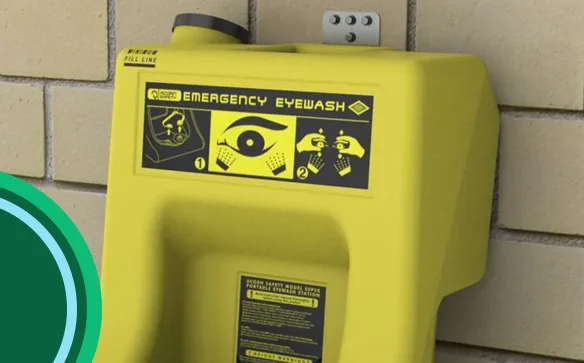
Drench hoses provide targeted emergency water focused exactly where it is needed.
Safety eye wash fountains provide 23.47 litres of water per minute to comply with the regulations for emergency eye wash stations.
Safety showers are designed to provide 75 litres of water per minute to comply with the regulations for emergency showers.
Your one-stop shop for safety eye wash stations, safety showers and related products.
As a market leader in safety eye wash units, our products are renowned for their exceptional build quality, reliability, and value for money.
Whatever your requirements, we’re certain to have an eye bath unit that’s right for your workplace. Our wall mounted eye wash stations are designed to be fixed to a wall for unbeatable stability, while our freestanding eye wash stations can be installed close to particularly hazardous areas.
Our emergency decontamination showers also come in a range of mounting options. We supply wall mounted safety showers, ceiling mounted safety showers and freestanding safety showers to suit workplaces of all shapes and sizes.

Our portable eye wash station is perfect for site work in isolated areas with no access to clean, potable water.
Shop NowAt Safety-Eyewash.co.uk, we take safety very seriously. Our safety eyewash fountains and bath units are manufactured from the most robust and reliable materials available, such as ABS plastic and stainless steel, so that you and your employees can rest assured that they’ll be there for you when it counts.
All of our safety products are high visibility yellow so that they can be located with ease during an emergency. This is especially important when it comes to eye injuries when vision may be compromised.
Once installed, it is essential that you test your emergency eye bath fountain every week to safeguard against operational failure. Each of our products comes with an integrated inspection tag for your convenience and peace of mind. Wherever possible, our products undergo extensive pre-assembly before being dispatched, in order to make the installation process as simple as possible.
While we hope you’ll never have to use our emergency eye wash stations , we have a full list of operating manuals for training and installation purposes. This documentation will show you how to install, operate and maintain your safety products, and help you comply with the stringent ANSI regulations that govern emergency eye bath and fountain facilities. Visit our guide to the ANSI regulations to find out more.
In the financial year 2019/20, an estimated 693,000 British workers suffered a non-fatal injury at work. Aside from the obvious trauma that workplace injuries cause to those affected, they can also have a serious impact on productivity: of the reported injuries, some 525,000 resulted in up to seven days of absence from work and of those, 168,000 led to an absence of over seven days.
Factor in the cost of workplace injury compensation, court costs and fines for negligence, and it’s clear to see that ensuring the safety of your workers doesn’t only fulfil your moral obligations, but also makes good business sense.
Our emergency eye wash fountains are designed for use in laboratories, factories, garages, warehouses, petrol stations, foundries, chemical plants, farms, building sites, schools, colleges, universities, or any other facilities that involve the handling of corrosive or hazardous substances.
Examples of corrosive and hazardous substances include the following:
Upon contact with the body, the harm caused by these substances becomes graver with each passing second, and without immediate decontamination, the resulting injuries can lead to permanent scarring and disfigurement, blindness, and even death. That’s why access to emergency eye bath units and safety showers are an essential part of modern safety protocol.
Safety eyewash stations can also be of use in workshops used for carpentry, masonry and metalworking where airborne debris is an issue. Our emergency eye bath stations can be used to clear the eye of foreign objects such as swarf, sawdust and stone fragments.
If you’d like further information on our range of emergency eye baths and contamination showers, please call us on 01275 400456 or visit our contact page to send us a message.

You'd think that, given the importance of safety showers and eye wash stations, there would be a single body of regulations that you could consult for guidance - but there are in fact several. In this article, we'll look at the different regulatory documents and explain them in simple terms.
Read More
Here's a guide to mitigating the risk of legionella bacteria developing within your safety shower and emergency eyewash units. Essential reading to keep your team safe.
Read More
Your staff need to be properly trained when it comes to emergency equipment like safety showers and eyewash stations, but getting them interested in Health and Safety can be a challenge. We look at how you can shake up your essential training, get employees on board, and remain HSE compliant at the same tiime.
Read More
Emergency eyewash stations are essential in any working environment that involves the use of hazardous chemicals. When used properly, they can help prevent permanent injury, scarring, and even blindness. This simple, printable guide can be distributed among your colleagues to help them learn how to use an emergency eye wash unit the correct way.
Read More
Regular maintenance is essential for eye wash stations. Failure to maintain your stations can cause them to break down or become contaminated - they could even end up doing more harm than good. In this handy guide, we'll explain why eyewash maintenance is so important, and show you how to keep them clean and ready for use in an emergency.
Read More
At Safety-Eyewash.co.uk, we've spoken a lot about the importance of emergency decontamination showers - but how do you go about actually installing them? In this simple step-by-step guide, you'll find out everything you need to know about installing a safety shower (or multiple showers) in your workplace, including ceiling-mounted, wall-mounted and freestanding designs.
Read More